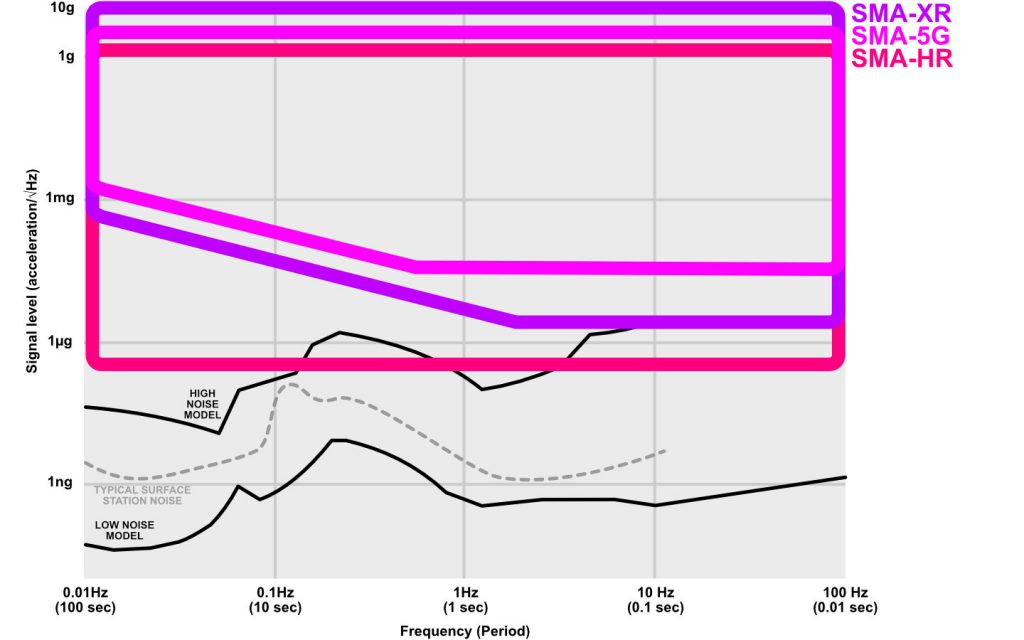Choosing an earthquake sensor is not straightforward. There are dozens of accelerometers and velocity sensors on the market, and picking one that meets your needs can be confusing. We have used many different sensors over the decades, so let us help you understand them a little better.
The current generation Gecko seismograph is, at its core, simply a data logger that records voltage. That voltage comes from seismic sensors, and the Gecko supports sensors from all manufacturers.
The Importance of Resolution
The main technological difference between a seismograph and other environmental monitoring data loggers is the combination of low noise, high resolution, wide input signal range, and how quickly it can sample data points.
Think of the difference in signal quality like video screen resolution – most environmental data loggers have about 16-bits of resolution, which is about the number of pixels on a Nintendo Game Boy screen. A seismograph has 24-bit resolution, which is equivalent the number of pixels on a modern high end television. You can still see a picture on both screens, but the detail and clarity of the high resolution system is in another league.

Seismic data loggers need to be able to differentiate between just a few “pixels” of signal to see ground motion from very small or very distant earthquakes, but they also need to be able to fully capture big signals millions of time larger during large/nearby earthquakes. This is why a low noise data logger with a wide dynamic range like the Gecko is critical to taking full advantage of whatever sensor you choose to connect.
Displacing the Earth
When seismologists monitor the earth, we are measuring ground displacement – how far the ground moves. Let’s say that a massive earthquake creates a permanent displacement of 10 metres at the surface. Remembering that we can measure about one 8-millionth of motion using a modern seismic data logger, the smallest difference we could detect with a 10m displacement sensor would only be about 0.001mm. That’s roughly the peak ground motion recorded about 100km from a magnitude 1 earthquake, or 500km from a magnitude 3 earthquake.
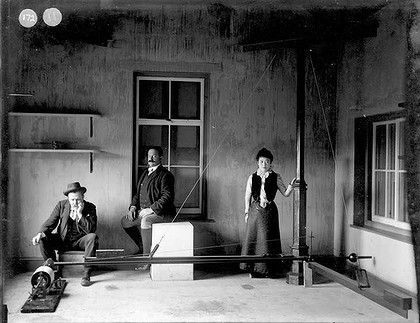
The problem is that you’d need a sensor than was 10m long! Sensors were invented that told us about change in displacement over a short period of time – i.e. velocity. The sensor, effectively a mass on a spring, could move only a few millimetres, but could theoretically measure that 10m of displacement if the velocity continued over many minutes. Seismologists had to sacrifice that large range for increased sensitivity, meaning nearby large earthquakes would go off the scale.
Sensors were then designed to tell us about change in velocity over time – acceleration. This would allow us to measure the largest of ground motions and still achieve sensitivity to small/distant earthquakes.
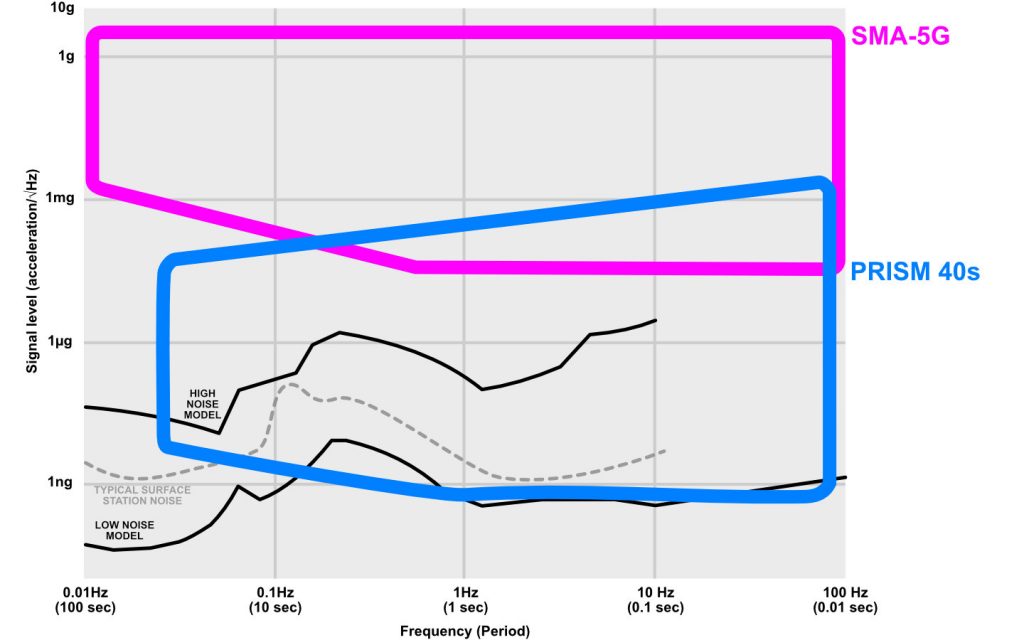
Velocity sensors are generally still more sensitive than acceleration sensors, but the gap is closing. Some accelerometers available today are more sensitive than some larger and costlier velocity sensors.
Most sensors have a greater range of detectability than we can record with a single 24-bit seismograph, which is why many earthquake monitoring stations have two sensors – one to record strong motion, and another to record weak motion. These sensors tend to overlap in range, which allows us to record pretty much the full range of ground displacement that the earth can throw at us.
So the decision on what type of sensor you need depends on what you’re trying to record. Are you interested in tiny levels of ground motion, only strong motion that can cause damage to infrastructure, or a combination? There are dozens of option out there, so we’ll look at the common sensors are used with the Gecko recorder.
Velocity Sensors
The lowest cost velocity sensors are high frequency geophones that can typically record signals that shake at around 5Hz (5 cycles per second) or faster, and they can record very large signal levels. This is fine for nearby events where a majority of the energy is in this frequency/amplitude range, but if your sensor is more than a few kilometres from the source of the vibration, the signal starts to disappear. These sensors are used for near-source blast monitoring or to monitor construction and demolition work, and are often used in conjunction with a microphone to measure air pressure vibrations.
Lower frequency geophones are a little larger and are naturally sensitive to lower amplitudes and frequencies (down to 1-2Hz). These are good for detecting earthquakes within about 500km of the sensor, but will saturate if subjected to a nearby magnitude 5+ earthquake.
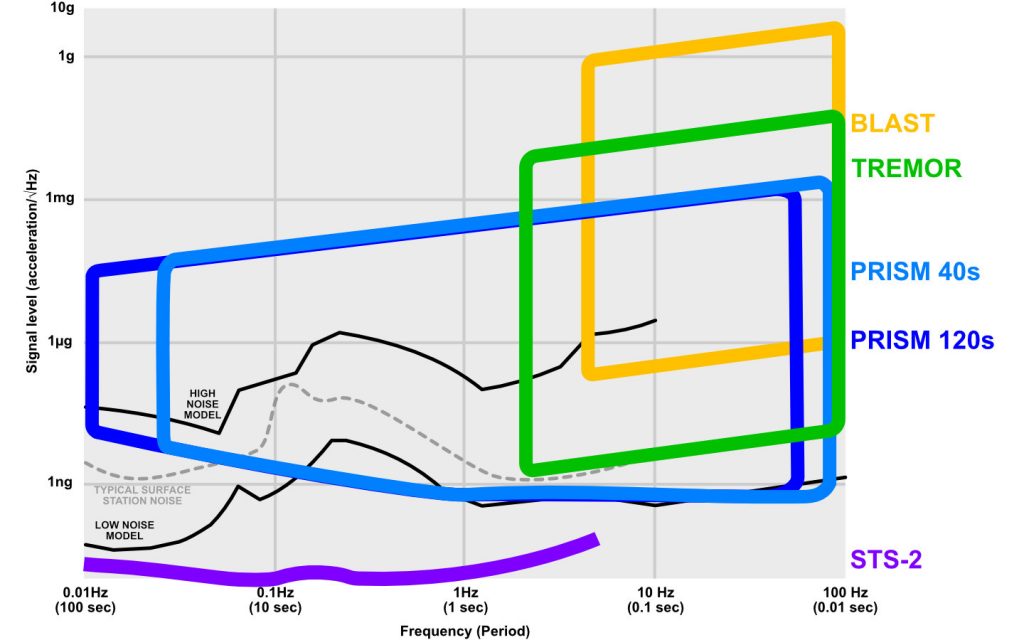
Most of the high frequency energy from earthquakes is absorbed by the earth in the first few hundred kilometres, leaving only low frequency waves (below 1Hz) travelling around the globe. We start to refer to these wavelengths in period (the number of seconds it takes for one cycle of motion). Velocity sensors with long period responses of 40-seconds and 120-seconds are commonly available for monitoring regional and global earthquakes at distances of thousands of kilometres from the sensor.
The most sensitive velocity sensors can detect energy waves as long as 360 seconds, and are so sensitive they can detect the influence of the moon’s gravitational deformation of the earth’s surface. These sensors are often buried deep underground in quiet locations, but can still be cabled to a Gecko seismograph to accurately record their output.
Acceleration Sensors
Acceleration sensors are used in many devices – in your phone to work out which way you’re holding it, in virtual reality controllers to track hand and head motion, and in your car waiting to trigger an airbag on impact. These sensors are usually low cost electronic chips with limited resolution, which is fine for their application, but their manufacturers also make high sensitivity accelerometers for seismic applications.
Some of these micro-electromechanical system (MEMS) accelerometers are very small and sensitive enough to overlap with the upper range of a velocity sensor, or to be used as a near-field monitor in the same way as a high frequency geophone. MEMS sensors often have a saturation level of ±5g, useful for high amplitude nearby blast and vibration monitoring.
Another type of accelerometer is one that uses integrated electronic piezo-electric (IEPE) technology. They use more power than MEMS and are several times more expensive, but they have better low-amplitude and low-frequency sensitivity, and with a higher saturation level of +10g.
The most sensitive accelerometers use optical or mechanical elements with feedback electronics to maximise sensitivity, and are slightly more expensive again. They are typically are available with ±2g maximum range, but are super sensitive to low amplitude and low frequency motion. These sensors can detect signal amplitudes of less than 1-millionth of the force of gravity, and can detect signal frequencies from 200-second period to 800Hz without amplitude distortion.
Convertible Sensors
The optical acceleration sensors that we have been using in our building monitoring systems have a greater range than we can record with a 24-bit recorder. They are so sensitive that if we just focussed on the lower end of their range we can see a greater sensitivity to ground displacement than geophone-based solutions. You would need about 36-bits of noise-free range to see the full range of these sensors, and although 32-bit components exist, about 8-bits are useless noise. Analogue sensor technology development is outpacing digitisation technology.
To take advantage of this sensitivity, we worked with sensor designers to create a Gecko Prism-SP with a convertible sensor that can be switched from operation as a high-sensitivity 10-second period velocity sensor (using the bottom end of the sensor range) to a ±2g accelerometer, depending on your deployment needs.

Finding Displacement
Ultimately we are interested in how the ground moved – its displacement. Velocity and acceleration sensors are simply ways to measure large displacements using small devices. Displacement can be derived from velocity (or acceleration) by using mathematical integration (or double integration). If you are using a low noise acceleration sensor, you might be surprised by what you can see once converted to velocity or displacement.
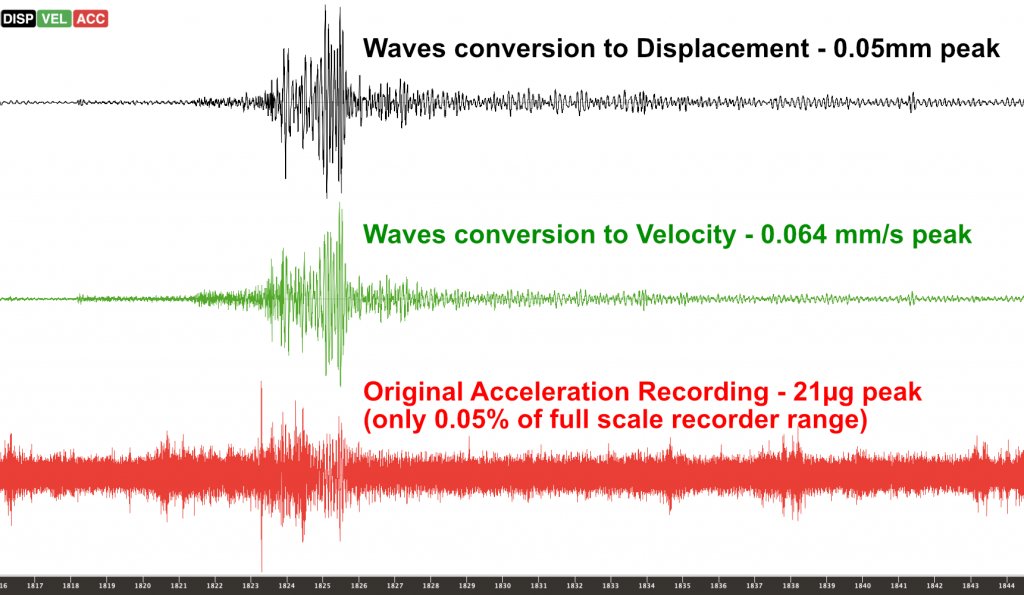
We have built this unit conversion functionality into our Waves earthquake waveform analysis software. If your data has come from a Gecko and you selected your sensor from the list of popular models, converting between units of ground motion is as simple as pressing a button. Waves is free and is available for Windows, macOS and Linux.
Did you know that southeast Australia averages around 30 earthquakes per week? We post seismic activity maps every week on LinkedIn – follow us today.

